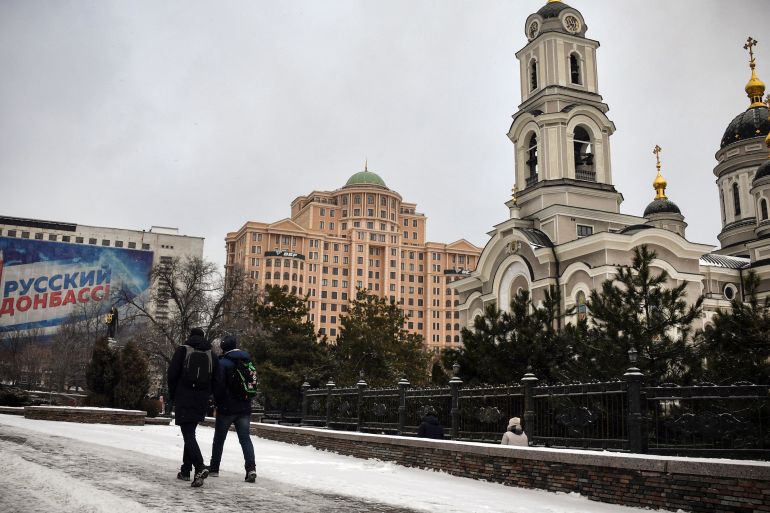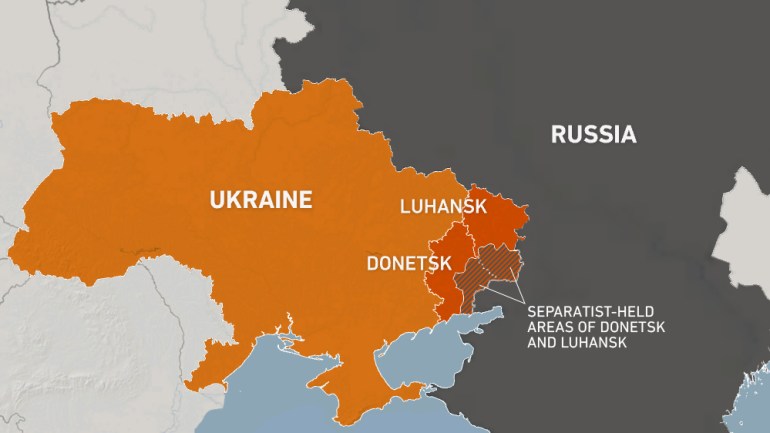Ukraine crisis: Who are the Russia-backed separatists?
About 4 million live in two pro-Russia statelets, including fighters who were born in Ukraine and Russian volunteers.

Moscow, Russia – Since fighting broke out in eastern Ukraine in 2014, separatist rebels of the self-proclaimed Donetsk and Luhansk People’s Republics have been accused of being proxies for Russian interests, if not simply Russian soldiers in disguise.
The conflict in Ukraine’s Donbas region is therefore framed as a war between Russia and Ukraine, in Ukrainian and most Western media, as opposed to a civil war.
Keep reading
list of 4 itemsWill Ukraine go East or West – or both?
Soviet nostalgia on Ukraine’s impoverished front line
Russia-Ukraine crisis: When oil prices climb, Putin gets bolder
But who exactly are the rebels in the statelets known as the DPR and LPR, home to 2.3 million and 1.5 million people respectively?

Despite efforts by the central government in Kyiv, Ukraine is deeply divided, with a large Russian and Russian-speaking minority, especially in the south and east of the country.
Some in these regions viewed the Maidan revolution of early 2014 as an ultranationalist uprising, involving far-right paramilitaries such as Right Sector, with echoes of the anti-Soviet partisans which collaborated with the Nazis in WWII.
Tensions reached boiling point over the following months, with many pro-Russian activists burned alive in a trade union building after street clashes in Odesa.
Protesters in eastern Ukrainian cities such as Donetsk occupied buildings and erected checkpoints and barricades. They were joined by members of the Berkut riot police, which had been battling and sometimes abusing Maidan protesters in Kyiv months earlier.
An “anti-terrorist operation” was ordered by Kyiv, and the protests exploded into an armed uprising, then an all-out war.
By the end of 2014, Russia had annexed the Crimean peninsula.
Here’s where the picture grows even more complicated.
Although Ukrainian citizens such as Alexander Zakharchenko, Pavel Gubarev and Denis Pushilin occupied key positions in the rebel leadership, Russia, which has its own interests in Ukraine – namely, keeping NATO from its western border – has been accused of providing the separatists with weaponry and manpower.
Moscow’s official line is ambiguous. Russian President Vladimir Putin has before referred to the rebels as the “militia of New Russia”, using an imperial-era label for southern Ukraine.
But no UN members, including Russia, recognise the “republics”.
In recent weeks, however, amid the resurgent Ukraine tensions, Russian politicians did discuss official recognition – the Kremlin ultimately dismissed this idea as an inflammatory move.
Even so, it is understood that the while majority of separatist fighters were born in Ukraine, there are significant numbers of Russians among them. Russia has also handed out passports to hundreds of thousands in the rebel-controlled areas.
‘I was a real volunteer’
Fyodor (not his real name), a Russian who volunteered to fight alongside the rebels in 2014 when he was in his early thirties, told Al Jazeera from Moscow: “Once, on patrol, we captured three Ukrainians who were also on patrol.
“I got to chatting with one of them, who thought they were going to be shot. I told him everything will be fine and he replied, ‘I’m still not telling you anything.’ I said, fair enough. He was so brainwashed, he believed there were Russians everywhere; Chechens slitting throats and raping women. I told him, look around you: there are the three of us Russians, and the rest are all locals.”
The pro-Russian feeling among many – but certainly not all – residents of the Donbas region should not be dismissed. Nevertheless, both veteran and serving Russian soldiers reinforced the rebels’ ranks.
But their number, and the number of volunteers who joined the “cause”, are unclear.
According to CNN, which cited Ukrainian intelligence, there are an estimated 35,000 separatists in the region, supported by 3,000 Russian soldiers; Al Jazeera was unable to independently verify these figures.
In mid-2015, the Ukrainian government claimed that there were 42,500 fighters on the separatists’ side, including 9,000 Russian soldiers.
Fyodor, now working in advertising, said he arrived voluntarily.
Yuri Tikhonov, who also fought for the rebels in his early thirties, told Al Jazeera: “I was a real volunteer – I didn’t see a single rouble for half a year.
“All I got for my service was a few pairs of socks, underpants, a little bus fare home and a gun.”
Tikhonov, now in Saint Petersburg and working in construction, said he understands that the rebel republics are “two quasi-states controlled entirely by Moscow”.
“I don’t know why they decided to create not one, but two, each with its own army. It’s stupid, but they did it anyway,” he said.
Among the Russian contingent was a number of Chechens.
In 2014 Ramzan Kadyrov, the head of the Chechen Republic and an ally of Russian President Vladimir Putin, declared he was ready to dispatch 74,000 fighters to Ukraine, adding that any Chechens who were in Donbas already were purely volunteers.
“One time, we were all sitting around drinking. This older Chechen was sitting there all serious,” said Fyodor. “He said, ‘You know, I used to fight against you [the Russians] but that’s all in the past, we’re together now.’
“Turns out in ‘96 he was just sitting at home watching TV, when suddenly a tank crashed through his home. I told him that funnily enough, I had a friend who was serving in Chechnya then, who’d also crashed a tank through a house in a village at around that time.”
Another younger Chechen told Fyodor he was ordered to travel to the self-proclaimed republics by his father.
“We had Ossetians there, we had veterans of [the Soviet war in] Afghanistan,” Fyodor claimed, adding that a Brazilian anti-fascist activist was also among the separatists. “Here in Moscow we’re used to seeing faces of all colours, but over there he really stood out.”
The rebels are known for their harsh stance on law and order.
For instance, drug addicts in eastern Ukraine used to receive regular methadone fixes from Kyiv, but were cut off by officials in DPR and LPR, who imposed a zero-tolerance policy with summary executions and forced labour.
Addicts were forced to dig trenches at gunpoint by Kalashnikov-wielding fighters, while suspected dealers were taken out to the countryside and shot, despite many of the fighters having colourful pasts themselves.
In 2015-2018 there was a series of assassinations of top rebel commanders, including Alexander Zakharchenko, who was killed in a café bombing.
Ukrainian security services were blamed by Russia and the separatists, while Ukrainian officials said the killings were probably consequences of an internal power struggle.